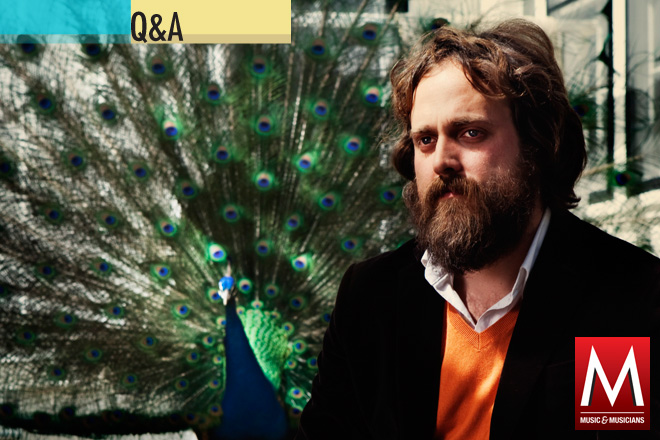IRON & WINE
Making a clean break with some help from a little kiss of R&B
From the spare solo acoustic songs of Iron & Wine’s early-2000s work to the expansive arrangements of the new Kiss Each Other Clean, Sam Beam has consistently steered his songs in ever more complex directions. For his latest, Beam drew from the sounds he heard on the radio as a kid, expanding his rustic folk sensibility with R&B horns, Afro-pop polyrhythms and the occasional analog synthesizer—and fans shouldn’t be surprised if they hear a little Fleetwood Mac influence, too. “I’m a cross-genre listener,” Beam says with a smile, relaxing backstage in New York City. “I like lots of stuff.”
What’s different about this record?
Many things. One of the things that’s new to this one is an R&B sentiment. There are more vocal arrangements instead of just harmonies, horn sections. There are a lot more keys than guitar on this one.
How long did you spend recording?
We worked on it about nine months, on and off. I tend to record like making a painting—make some marks and go away, have a sandwich or something, then come back and look at what you’ve done. Then make more marks or erase stuff—or scrap the whole thing. I work in stages. Much like writing, it’s more about rewriting and editing than it is about the basic inspiration.
Have you become more experimental?
Oh yeah. It wasn’t like I was stifling stuff at the beginning, I was just working with what was around me and what I thought was right. I do remember being very into finding the perfect setting for lyrics. Now it’s more about seeing how many different sets of clothing you can put on something to see which one is the most interesting or works best in the group of songs. It’s definitely all about experimenting—though I don’t consider my music very experimental. I don’t like the idea of putting the same record out twice.
What was your approach in the studio?
The last couple of records were click-track things, which was more out of necessity than desire. So this time I corrected that. I wanted to do it live, which has a different feel. I’m proud of the work I’ve done the other way, and it’s fun—but at the same time, I enjoy playing with people and the feel that you get from it. I like being surprised by the people I play with. That’s what’s fun about music. It’s important to be inspired by people, rather than just translating what’s in my head. So making the records is much more collaborative, but writing songs is still a solitary thing.
What’s your writing process like?
I don’t really write records. I just write, and when it’s time to do a record I look through what I’ve got and pick out songs I think would work together. Some have a loose thematic thing. A lot of the songs on the last record had a dog image in them, and on this one the river seemed to be a common thing. So some songs got included because they had a river.
Are you drawn to particular themes?
You have love, that’s a big part of it. Belief in God or fate, whether what’s happening is good or bad. Mortality—how long do I have, and what does it all mean? On a base level, you have those three things: God, love, death. The best is when you get all three of them in one tune, but one is usually pretty good.
–Eric R. Danton




comment closed